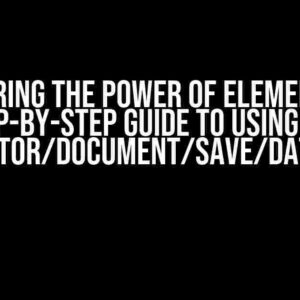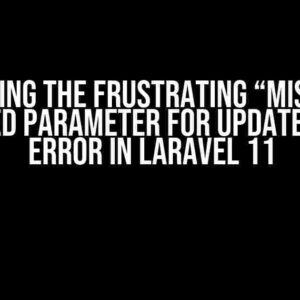Are you tired of manually calculating complex formulas on your WordPress site? Do you want to automate the process and make it more efficient? Look no further! In this comprehensive guide, we’ll take you through the process of implementing a formula in PHP and integrating it into your WordPress site. Buckle up, and let’s dive in!
Understanding the Formula
Before we begin, it’s essential to understand the formula you want to implement. Take a moment to write it down and identify the variables involved. For the sake of this example, let’s assume we’re working with a simple formula to calculate the area of a rectangle:
A = L × W
Where A is the area, L is the length, and W is the width.
Setting Up Your PHP Environment
To implement the formula in PHP, you’ll need a PHP development environment set up on your local machine. If you’re new to PHP, don’t worry – it’s easier than you think! Here are the basic steps:
- Download and install XAMPP (or your preferred PHP development environment) on your local machine.
- Create a new folder for your project and create a new PHP file (e.g.,
formula.php) inside it. - Open your PHP file in a code editor (e.g., Sublime Text, Atom, or Visual Studio Code) and get ready to code!
Implementing the Formula in PHP
Now that you have your PHP environment set up, it’s time to implement the formula. In this example, we’ll create a function called calculateArea() that takes two arguments, $length and $width, and returns the calculated area:
<?php
function calculateArea($length, $width) {
$area = $length * $width;
return $area;
}
?>
This code defines the function, multiplies the length and width, and returns the result. Simple, right?
Testing the Formula
Before we integrate the formula into our WordPress site, let’s test it to ensure it’s working correctly. Add the following code to the same PHP file to test the function:
<?php
$length = 5;
$width = 3;
echo "The area is: " . calculateArea($length, $width);
?>
Save the file and run it in your browser. You should see the following output:
The area is: 15
Integrating the Formula into Your WordPress Site
Now that we’ve tested the formula, it’s time to integrate it into your WordPress site. To do this, we’ll create a custom plugin that will house our formula function. Yes, you read that right – a plugin!
Creating the Plugin
Create a new folder in the wp-content/plugins directory of your WordPress site, and create a new PHP file (e.g., formula-plugin.php) inside it. Add the following code to the file:
<?php
/*
Plugin Name: Formula Plugin
Description: A plugin to implement a formula on your WordPress site
Version: 1.0
Author: Your Name
Author URI: https://yourwebsite.com
*/
?>
This code defines the plugin’s metadata. Save the file and activate the plugin in your WordPress dashboard.
Adding the Formula Function to the Plugin
Now, add the calculateArea() function to the plugin file:
<?php
function calculateArea($length, $width) {
$area = $length * $width;
return $area;
}
?>
Save the file and refresh your WordPress dashboard. The plugin is now active, and the formula function is ready to be used!
Using the Formula in Your WordPress Site
To use the formula on your WordPress site, you can create a custom shortcode or add it to a page or post using PHP code. For this example, let’s create a shortcode:
<?php
function formula_shortcode() {
$length = 5;
$width = 3;
$area = calculateArea($length, $width);
return "The area is: $area";
}
add_shortcode('formula', 'formula_shortcode');
?>
Save the file and add the [formula] shortcode to a page or post on your WordPress site. When you view the page, you should see the calculated area displayed:
The area is: 15
Tips and Variations
Congratulations! You’ve successfully implemented a formula in PHP and integrated it into your WordPress site. Here are some tips and variations to take your formula to the next level:
- Input validation**: Add input validation to ensure that the user-provided values are numbers.
- Error handling**: Implement error handling to handle potential errors, such as division by zero.
- Complex formulas**: Experiment with more complex formulas, such as quadratic equations or trigonometric functions.
- User input**: Allow users to input values for the formula using HTML forms or JavaScript.
- Visualization**: Use visualization libraries like Chart.js or D3.js to display the results in a graphical format.
Conclusion
Implementing a formula in PHP and integrating it into your WordPress site may seem daunting, but with these step-by-step instructions, you’re well on your way to automating complex calculations and taking your WordPress site to the next level. Remember to test, test, test, and don’t be afraid to experiment and try new things. Happy coding!
| Formula | PHP Implementation | WordPress Integration |
|---|---|---|
| A = L × W | function calculateArea($length, $width) { … } | Shortcode or PHP code in a plugin or theme |
Now, go forth and unlock the power of PHP and WordPress!
Frequently Asked Question
Get the inside scoop on implementing a formula in PHP for your WordPress site!
What is the best way to implement a formula in PHP?
To implement a formula in PHP, start by breaking down the formula into individual components. Then, use PHP’s arithmetic operators (+, -, \*, /, etc.) to perform the necessary calculations. Don’t forget to assign the result to a variable, and you’re good to go!
How do I convert my formula into a PHP function?
To convert your formula into a PHP function, simply wrap the formula in a PHP function declaration. For example, `function myFormula($input1, $input2) { return ($input1 + $input2) / 2; }`. This way, you can easily reuse the formula throughout your code.
Can I use my PHP formula in a WordPress site?
Absolutely! You can use your PHP formula in a WordPress site by creating a custom plugin or theme. Simply create a new PHP file, paste your formula, and then hook it into your WordPress site using the desired action or filter.
How do I troubleshoot issues with my PHP formula?
If your PHP formula isn’t working as expected, try using PHP’s built-in debugging tools, such as `var_dump()` or `print_r()`, to inspect the formula’s output. You can also use WordPress’s debug log to identify potential issues.
Are there any security concerns when using PHP formulas in WordPress?
Yes, when using PHP formulas in WordPress, it’s essential to sanitize and validate user input to prevent potential security vulnerabilities. Use WordPress’s built-in sanitization functions, such as `sanitize_text_field()`, to ensure your formula is secure and reliable.



